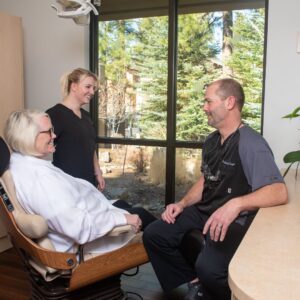 Missing teeth are super cute in kids but not so much in adults. Thankfully, there are ways to replace adult teeth, restoring your smile to its former glory. But, before this can happen, you must ensure the tooth’s former home doesn’t collapse. In this blog, learn the importance and significance of bone grafting.
Missing teeth are super cute in kids but not so much in adults. Thankfully, there are ways to replace adult teeth, restoring your smile to its former glory. But, before this can happen, you must ensure the tooth’s former home doesn’t collapse. In this blog, learn the importance and significance of bone grafting.
First off, the body has a remarkable capacity for healing. When an adult tooth comes out – whether by extraction, trauma, or some other reason – the gap created will not stay that way without some help. The bones are the foundation. When a tooth comes out (as an adult), the integrity of the area where the tooth used to be is compromised. It can and will collapse and be reabsorbed – as will the gum tissue. This can lead to tremendous amounts of sensitivity. So, now you have a gap in your smile and the always-on feeling of an ice cream headache. And misery loves company, so this lovely scenario will spread to neighboring teeth over time. Doesn’t that sound glorious?
What to do in the event of a missing tooth
If you have a missing tooth, it is critical that you get a bone graft. A bone graft adds stability to the teeth located next to the extraction site. This keeps neighboring teeth as stable as possible and prevents the mentioned issues. Teeth and dental implants need bone to be retained. Gum tissue isn’t enough to keep solid structures (teeth and dental implants) in place. Plus, even if you aren’t ready to invest in a dental implant, you have the area bookmarked for when you are. Dental implants need bone to stay in place. If you don’t prepare the area with a bone graft, the site will degrade, and you can kiss your chance of having a successful implant goodbye.
How is a bone graft performed?
You should do a happy dance right now because your body can grow bone where it is needed. Ideally, a bone graft is completed at the time of tooth extraction. However, as we all know, sometimes teeth have a way of falling out on their own, whether due to trauma or a health condition. In this case, getting your mouth to the dentist’s office as soon as possible is essential.
At Living Dental health, Dr. Andy provides options so his patients can heal as quickly as possible, with minimal discomfort.
There are two options for bone grafts.
- Bone graft with sutures and Gortex membrane – healing time is about six weeks in length.
- Bone graft au natural – healing time is about four months.
Bone grafts are taken from a donor site on your body (jaw, hip, or tibia) or a tissue bank. Both are excellent options; however, if you want to heal as fast as possible, the first option is best. In this scenario, once the bone graft is placed, a tissue graft is placed over the bone to speed healing. Then a Gortex membrane is sutured to protect the area further and hasten recovery. Dr. Andy uses tissue grafts to add another layer of protection. Plus, the tissue graft comes in handy down the road when an implant is placed. Dr. Andy likes to save his patients time and money. Getting the tissue graft at the time of the bone graft saves you from additional surgery.
The right bone graft option depends on the individual. Once the graft is fully healed, an implant can be placed. A dental implant typically takes 4-6 months to heal, but this time depends on the site it is placed and the individual.
We would love to have you keep all your teeth, but sometimes that isn’t possible. If you have a tooth that needs to be extracted or comes out due to trauma, we are here to help. Call our office to schedule an appointment with Dr. Andy. During the appointment, he will discuss the options available based on your unique situation.
